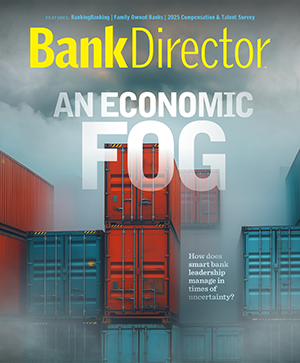Polo Rocha is a contributing writer for Bank Director.

Why Fed Cuts May Not Lower Deposit Costs Quickly
Banks may find it tough to lower deposit rates in the current environment, but they may benefit anyway.
Banks are hoping the Federal Reserve’s resumption of interest rate cuts will usher in lower deposit costs, but they may be disappointed in how quickly that’ll happen.
The industry will certainly benefit, as posters at branches touting certificates of deposit that pay promo rates closer to 4% get replaced by new ones paying 3.5% or less. The problem is that more customers today are getting paid interest, as many whose cash sat in noninterest bearing accounts switched to accounts that paid them.
The switch is making the pool of funds that banks pay interest on bigger, analysts say, even as the rate they pay gets smaller. It is one reason why banks didn’t see deposit costs drop much after the Fed’s rate cuts last year — a dynamic that is persisting as the Fed lowers rates again.
“We’re still seeing slippage there,” says Matt Pieniazek, CEO of Darling Consulting Group.
Interest-bearing deposits rose to 77% of deposits in the second quarter, up from 71% in the same quarter three years ago, according to aggregate data from Darling Consulting’s bank clients. The switch has happened among consumer and business clients alike, Pieniazek says, suggesting some level of pressure across the industry even though banks’ deposit mixes vary.
The industry’s average cost of deposits was 2.09% in the second quarter of 2025, well above the five-year low of .12% in the first quarter of 2021, according to the Federal Deposit Insurance Corp.
The good news is the shift toward interest-bearing deposits seems to have largely played out, suggesting deposit costs peaked late last year, Jefferies bank analyst David Chiaverini wrote in a note to clients last week. But a significant shift back to noninterest bearing deposits would require rates to fall more, he added.
The Fed’s quarterly projections suggest two more rate cuts may be coming this year, but only one in 2026 — a slower path than markets had anticipated.
This month’s rate cut brought the Fed’s effective benchmark fed funds rate to a target range between 4.0% and 4.25% last week, down from a post-COVID high of just above 5.25%.
CD Churn
With the Fed’s key rate still north of 4%, it’s been hard for banks to bring CD rates closer to 3%. Rates on 1-year CD specials have generally been able to breach 4%, Pieniazek says, but they’ve struggled to come down much further. As of July 11, more than 1,000 institutions were marketing one-year CDs with rates above 3.5%, according to S&P Global Market Intelligence, down only slightly from earlier in the year.
Even as CD rates come down, many banks are finding that their consumer deposit costs are up, says Adam Stockton, head of retail deposits and lending at the consulting firm Curinos.
That’s because of the “ongoing churn” as consumers move money from noninterest bearing or low-rate accounts onto higher-paying CDs, he says. “They feel like they’ve lowered rates as far as they can, but that churn is still driving costs higher,” Stockton says.
Business Remix
Banks have also seen a “real remixing” among their business depositors, Stockton says. Three years ago, he says, over half of commercial deposits didn’t get interest payments or got a negotiated “earnings credit rate” that gave them a discount on bank services rather than interest.
The big benefit of those demand deposit accounts (DDA) for businesses is that they can withdraw money on-demand, giving them more liquidity to pay suppliers or deal with emergencies.
But now, only a third of banks’ commercial deposits don’t receive interest, Stockton says. Companies have chosen to move some of their spare cash onto interest-bearing accounts and get some yield instead. “Once companies remix away from DDA, our perspective is: That’s probably going to be a slow ship to turn around,” Stockton says.
Asset Benefits
A slower decline in deposit costs doesn’t necessarily mean bad news for bank profitability, says Moody’s Ratings Senior Vice President Allen Tischler.
That’s because many banks still have fixed-rate assets from 2020 and 2021 — when interest rates were near zero — mature and renew at today’s higher interest rates.
For some, that boost to interest income helps offset the lag in deposit cost declines, Tischler says. It also helps offset pressures from banks’ floating-rate loans, which automatically reprice downward with Fed cuts and thus reduce banks’ interest income.
“You have loan yields coming down with rate reductions. You’ve got deposit costs coming down, but maybe not as quickly,” Tischler says. “On the surface, it sounds like it’s a constraint on net interest income, and it is. But that’s being offset by a repricing of assets at a higher level.”
That all bodes well for community banks’ net interest margins, which should rise from 3.42% in 2024 to 3.64% this year and 3.70% in 2026, according to S&P Global Market Intelligence projections.
Defense Versus Offense
The asset repricing is a real positive for banks and may ultimately prompt some to go slower on cutting deposit costs, Darling Consulting’s Pieniazek says. The fight for deposits following Silicon Valley Bank’s failure in spring 2023 has long since faded, but banks remain very cautious over any deposit outflows, Pieniazek says. With margins poised to go up due to asset repricing, some banks may decide that keeping customers’ deposit balances is a higher priority than cutting interest costs.
“As long as they’re getting the momentum on the asset side, I think the tie-breaker of balance versus cost is going to still be leaning more towards balance,” Pieniazek says, with some choosing to not be overly aggressive and stay defensive.
In recent weeks, investors have also worried that a seeming rebound in loan growth may prompt more deposit competition, with banks fighting for cash to fund those loans and play offense. There are pockets of more intense competition starting to emerge in higher-growth areas such as the Southeast, Jefferies’ Chiaverini wrote.
But banks also have more deposits than they used to, Chiaverini added, with strong liquidity levels that may tamp down the need to compete for funding. Most banks loan-to-deposit ratios have fallen over the years and are now below pre-pandemic levels, he notes.
Stronger loan momentum may keep competition going for deposits, Moody’s Tischler says. But recent commentary from bankers suggests many see loans growing in the mid-single digits, he notes, an improvement from the lackluster pace of years past but not a massive one. “It’s picking up, but it’s not going gangbusters,” Tischler says.


